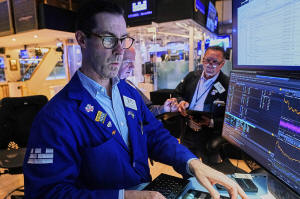A global rally for stocks loses steam amid questions about what will
happen to Trump's tariffs
[May 30, 2025] By
STAN CHOE
NEW YORK (AP) — A big rally for stocks that began in Asia on Thursday
lost steam after sweeping into Europe and the United States amid
uncertainty about what will happen next after a U.S. court blocked many
of President Donald Trump’s sweeping tariffs.
The S&P 500 rose 0.4% after giving up more than half of an early gain.
The Dow Jones Industrial Average added 117 points, or 0.3%, and the
Nasdaq composite rose 0.4%.
It’s a downshift after stocks initially leaped nearly 2% in Tokyo and
Seoul, where markets had the first chance to react to the ruling late
Wednesday by the U.S. Court of International Trade. The court said that
the 1977 International Emergency Economic Powers Act that Trump cited
for ordering massive increases in taxes on imports from around the world
does not authorize the use of tariffs.
The ruling at first raised hopes in financial markets that a hamstrung
Trump would not be able to drive the economy into a recession with his
tariffs, which had threatened to grind down on global trade and raise
prices for consumers already sick of high inflation. Trump has said he
wants to bring manufacturing jobs back to the United States, and he
warned the process could cause some pain for U.S. households.

But the tariffs remain in place for now while the White House appeals
the ruling, and the ultimate outcome is still uncertain. The court’s
ruling also affects only some of Trump’s tariffs, not those on foreign
steel, aluminum and autos, which were invoked under a different law.
Trump “is still able to impose significant and wide-ranging tariffs over
the longer-term through other means,” according to Ulrike Hoffmann-Burchardi,
chief investment officer of global equities at UBS Global Wealth
Management.
Such uncertainty helped dampen the excitement in financial markets as
trading headed through Europe into the United States, where the moves
were much more modest than in Asia. The U.S. court’s move was
nevertheless seen as a positive for financial markets.
“The bar is raised for President Trump to resurrect his tariffs,” said
Brian Jacobsen, chief economist at Annex Wealth Management.
“Markets are pricing that this is a better type of uncertainty than what
we’ve had since Liberation Day,” which is what Trump called his April 2
announcement of a worldwide set of sweeping tariffs.
The S&P 500 has pulled within 3.8% of its all-time high after dropping
roughly 20% below at one point last month.
On Wall Street, tech stocks led the way after Nvidia once again topped
analysts’ expectations for profit and revenue in the latest quarter.
The chip company has grown into one of the U.S. market’s largest and
most influential stocks because of the frenzy around
artificial-intelligence technology, and its 3.2% rise was the strongest
force by far lifting the S&P 500.
C3.ai, an AI application software company, jumped 20.8% after it
reported stronger profit than analysts expected for its latest quarter.
It also said the U.S. Air Force increased the maximum possible value for
its contract by $350 million to $450 million. The company’s revenue last
quarter totaled $108.7 million.
[to top of second column] |

Specialist John McNierney, left, works with traders on the floor of
the New York Stock Exchange, Thursday, May 29, 2025. (AP
Photo/Richard Drew)
 E.l.f. Beauty was another big winner
and rose 23.6% after the cosmetics company delivered a stronger
profit for the latest quarter than analysts expected. It also said
it agreed to buy Hailey Bieber’s Rhode skincare brand in a $1
billion deal. Rhode had $212 million in net sales in the 12 months
through March.
Bieber, a model and the wife of singer Justin Bieber, will be
Rhode’s chief creative officer and head of innovation and also a
strategic advisor to the combined companies.
They helped offset a drop for Best Buy, which fell 7.3% even though
it reported a stronger profit than expected. Its revenue fell short
of analysts’ forecasts.
The electronics retailer also cut its forecasted ranges for revenue
and profit over the full year on the assumption that “tariffs stay
at the current levels for the rest of the year, and there is no
material change in consumer behavior from the trends we have seen in
recent quarters,” Chief Financial Officer Matt Bilunas said.
Many companies have recently said that the uncertainty caused by
tariffs is making it too difficult to offer any financial forecasts
for the upcoming year.
All told, the S&P 500 rose 23.62 points to 5,912.17. The Dow Jones
Industrial Average added 117.03 to 42,215.73, and the Nasdaq
composite gained 74.93 to 19,175.87.
In the bond market, Treasury yields eased following some mixed
reports on the economy. One said that the U.S. economy likely shrunk
by less in the first three months of the year than earlier
estimated. Another said slightly more U.S. workers applied for
unemployment benefits last week than economists expected.
The yield on the 10-year Treasury fell to 4.43% from 4.47% late
Wednesday.

In stock markets abroad, Japan’s Nikkei 225 jumped 1.9% to help lead
Asian markets higher, while stocks rose 1.4% in Hong Kong and 0.7%
in Shanghai. South Korea’s Kospi rallied 1.9% after the Bank of
Korea cut its key interest rate to ease pressure on the economy.
The moves for European stocks were much more muted. France’s CAC 40
and Germany’s DAX both swung from early gains to modest losses.
___
AP Business Writers Matt Ott and Elaine Kurtenbach contributed.
All contents © copyright 2025 Associated Press. All rights reserved |